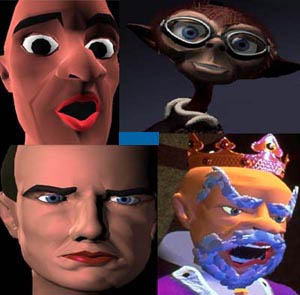|
iTechComputerAnimation Content2Page |
|
Intro
to Facade
|
Facade: a facial animation system

Introduction to Facade
Fašade is a parameterized facial animation system that uses a fixed polygon face topology. It can be used to create and animate facial types as well as facial expressions. The first version of the software was written by Steve DiPaola and later developed by the class of Art173A - Facial Animation (Winter 2001) at Stanford University. See the Credits for more information.
What can you do with Fašade?
- You can use Fašade to create character types, from human-like realistic characters to exaggerated cartoon characters.
- You can use existing character types or expressions to create new ones of your own by changing selected facial characteristics. After creating characters, you can create your own animation short.
- You simply set key frames that Fašade can then interpolate between.
- You can include automatic lip-sync in your animation.
Who can use Fašade?
Pretty much anybody can use Fašade. If you would like to experiment with creating character types, facial expressions and animated shorts using faces then Fašade would be an appropriate tool to use. The Smart Library provided with the software has multiple character types and expressions so if you are a beginner you don't have to start from scratch. You can easily use and modify existing faces.
The first version of the software was written by Steve DiPaola and later developed by the class of Art173A - Facial Animation (Winter 2001) at Stanford University. Here is the complete list of the people who contributed to facade. It was then extend by SFU's Itech614 3d Computer Animation where students created a new gui and a better texture mapping system.
Let's Look at Facade
Stanford Movement - Facade Site